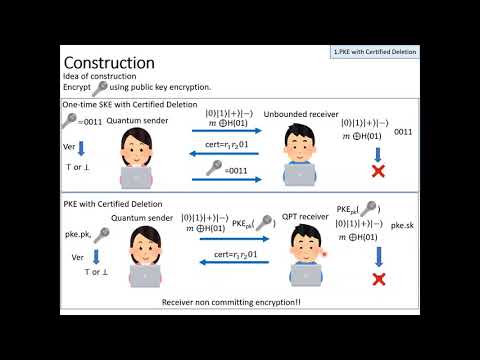CryptoDB
Quantum Encryption with Certified Deletion, Revisited: Public Key, Attribute-Based, and Classical Communication
| Authors: |
|
|---|---|
| Download: | |
| Conference: | ASIACRYPT 2021 |
| Abstract: | Broadbent and Islam (TCC '20) proposed a quantum cryptographic primitive called quantum encryption with certified deletion. In this primitive, a receiver in possession of a quantum ciphertext can generate a classical certificate that the encrypted message is deleted. Although their construction is information-theoretically secure, it is limited to the setting of one-time symmetric key encryption (SKE), where a sender and receiver have to share a common key in advance and the key can be used only once. Moreover, the sender has to generate a quantum state and send it to the receiver over a quantum channel in their construction. Deletion certificates are privately verifiable, which means a verification key for a certificate must be kept secret, in the definition by Broadbent and Islam. However, we can also consider public verifiability. In this work, we present various constructions of encryption with certified deletion. - Quantum communication case: We achieve (reusable-key) public key encryption (PKE) and attribute-based encryption (ABE) with certified deletion. Our PKE scheme with certified deletion is constructed assuming the existence of IND-CPA secure PKE, and our ABE scheme with certified deletion is constructed assuming the existence of indistinguishability obfuscation and one-way function. These two schemes are privately verifiable. - Classical communication case: We also achieve interactive encryption with certified deletion that uses only classical communication. We give two schemes, a privately verifiable one and a publicly verifiable one. The former is constructed assuming the LWE assumption in the quantum random oracle model. The latter is constructed assuming the existence of one-shot signatures and extractable witness encryption. |
Video from ASIACRYPT 2021
BibTeX
@inproceedings{asiacrypt-2021-31449,
title={Quantum Encryption with Certified Deletion, Revisited: Public Key, Attribute-Based, and Classical Communication},
publisher={Springer-Verlag},
doi={10.1007/978-3-030-92062-3_21},
author={Taiga Hiroka and Tomoyuki Morimae and Ryo Nishimaki and Takashi Yamakawa},
year=2021
}

